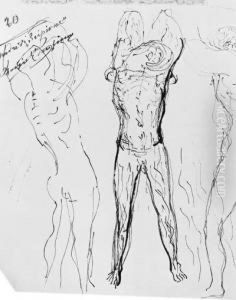Gino Bonichi Scipione Paintings
Scipione, born Gino Bonichi in Macerata, Italy, was an Italian painter associated with the expressionist movement Scuola Romana (Roman School). He adopted the pseudonym 'Scipione' and is known for his intense, expressionistic use of color and dramatic, often troubling, subject matter.
Scipione began his artistic training at the Istituto di Belle Arti in Rome, where he first encountered the work of the German expressionists, which would have a profound influence on his style. His early works already demonstrated a significant departure from the classical traditions that dominated the Italian art scene of the time, moving towards a more modern and expressionistic approach.
Throughout the 1920s, Scipione continued to develop his distinctive style, characterized by bold color choices and emotional intensity. His subject matter often dealt with themes of psychological distress, existential angst, and eroticism. He was deeply inspired by the works of other artists such as Otto Dix, Max Beckmann, and particularly Edvard Munch, whose influence is evident in Scipione's rendering of human suffering and alienation.
Scipione's work was also impacted by the dramatic political climate of Italy during the interwar years, with the rise of Fascism under Mussolini. Although he was not overtly political in his art, the sense of tension and unease present in his work reflects the broader social and political upheavals of his time.
Unfortunately, Scipione's career was cut short by his untimely death from tuberculosis at the age of 29. Despite his brief career, he left behind a powerful body of work that has been celebrated for its raw psychological force and its innovative approach to color and form. His work is considered a vital part of the Scuola Romana and has been exhibited posthumously in various retrospectives, securing his place in the canon of 20th-century Italian artists.











